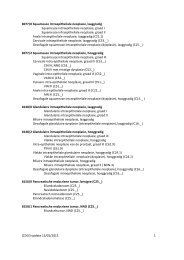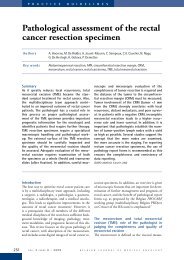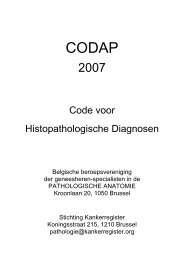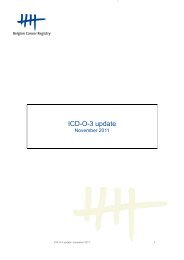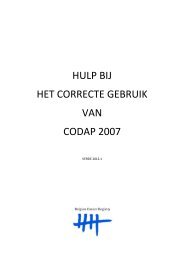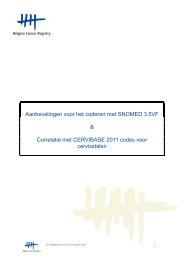Assurance de qualité pour le cancer rectal – phase 2 ...
Assurance de qualité pour le cancer rectal – phase 2 ...
Assurance de qualité pour le cancer rectal – phase 2 ...
Create successful ePaper yourself
Turn your PDF publications into a flip-book with our unique Google optimized e-Paper software.
KCE Reports 81 PROCARE <strong>–</strong> <strong>phase</strong> 2 47Figure 13 provi<strong>de</strong>s an overview of the per-centre-analysis using the administrativedatabase. Twelve centres (of which 11 centres treated 6 or <strong>le</strong>ss eligib<strong>le</strong> patients) have ascore of 0%, whi<strong>le</strong> in 8 centres all patients still have a stoma 1 year after SSO withtemporary stoma. All these 8 centres treated 2 or <strong>le</strong>ss eligib<strong>le</strong> patients. Forty-nine and54 centres have a score above the weighted (27%; 95%CI 24 <strong>–</strong> 30%) and unweightedmean (33%; 95%CI 28 <strong>–</strong> 38%) respectively. Risk-adjustment (e.g. tumour localisation,stage, comorbidities) is necessary for the correct interpretation of these results.Tab<strong>le</strong> 35. Number of patients with stoma 1 year after sphincter-sparingsurgery, measured with administrative data.NPatients with <strong>rectal</strong> <strong>cancer</strong> that un<strong>de</strong>rwent sphincter-sparing surgery 3692Patients with stoma surgery and/or use of stoma material within 1 year 1504Patients with stoma and availab<strong>le</strong> information on stoma after 1 year (<strong>de</strong>nominator) 1093Patients with stoma after 1 year (numerator) 292 (27%)Figure 13. Per-centre-analysis (n = 107) of stoma 1 year after sphinctersparingsurgery (administrative cohort) $ .Proportion (%)100908070605040302010050454035302520151050Number of patients (N)$ The weighted mean is presented with a red bar, the unweighted mean is presented with a bluehorizontal line. The grey bars represent the QI value per centre, whi<strong>le</strong> the blue dots representthe number of patients per centre. These results are preliminary, and cannot be used to judge thequality of care.Rate of patients with major <strong>le</strong>akage of the anastomosisDEFINITIONNumerator: all patients with RC un<strong>de</strong>rgoing sphincter-sparing radical resection andhaving major <strong>le</strong>akage of the anastomosis requiring re-intervention(s) during or afterhospitalisation for radical resection.Denominator: all patients with RC un<strong>de</strong>rgoing sphincter-sparing radical resection.Exclusion:• patients not un<strong>de</strong>rgoing sphincter-sparing surgery• patients un<strong>de</strong>rgoing LE/TEMSRESULTSOf the patients that un<strong>de</strong>rwent sphincter-sparing surgery, 5% had a major <strong>le</strong>akage of theanastomosis requiring re-intervention (Tab<strong>le</strong> 36). Importantly, the co<strong>de</strong> used tocalculate this QI does not take into account late <strong>le</strong>akages of the anastomosis.



